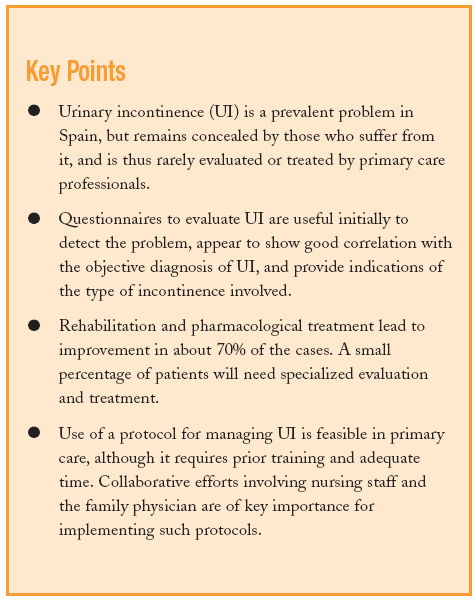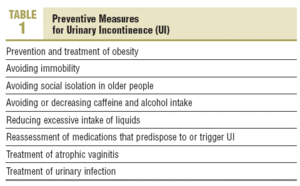Urinary incontinence (UI) is defined by the International Continence Society as the involuntary loss of urine through the urethra which can be demonstrated objectively, and which has social and hygienic repercussions for the patient. A number of studies have reported elevated prevalences that range from 5% to 59%. In Spain, several studies in primary care patients have reported a prevalence of UI of 15.4% among women aged 40 to 60 years, or around 30% in women older than 65 years, and a prevalence of 14% in older men.1 These figures are similar to the prevalence rates for other countries. Most of the variability in the results may be due to sampling bias (for age, sex, or educational level), differences in severity or type of incontinence, or the low rate of notification.
Although UI is a frequent health problem, few of those affected (20%-30%) seek professional help. Some of the reasons adduced are feelings of embarrassment, considering it a "normal" or inevitable problem at certain ages, or simply believing that there is no solution.2 It has been reported that the mean time until the patient considers UI a problem can be as long as 4 to 6 years. On the other hand, only 10% of all care providers ask their patients about continence, and the percentage of patients who are subsequently evaluated and treated is low.
In geriatrics, UI is considered one of the so-called geriatric giants, and its repercussions require evaluation from a medical, psychological and social perspective. Urinary incontinence in an older person predisposes the patient to the appearance of a variety of medical problems ranging from skin lesions (perineal dermatitis, pressure ulcers) to urinary tract infections, including urinary sepsis in fragile patients, or to falls and fractures--clear examples of cascading problems.
Moreover, UI is known to favor isolation and impoverished social relations, and can affect self-esteem to the extent that the individual develops depressive disorder. Urinary incontinence has also been identified as a variable associated with a greater likelihood of admission to a residential care facility. In addition, UI involves high pharmaceutical costs, as it is estimated that up to 3.2% of the
annual budget of the National Health System in Spain is spent on incontinence pads.3
The Cordoba Group for the Study of Urinary Incontinence is a good example of primary care research groups in Spain. The logically ordered sequence of projects this group has carried out during the last several years has comprised the evaluation of a well-defined population of older people, study of the prevalence of UI, and analysis of a number of sociodemographic variables and associated problems.4 As reported by Gavira Iglesias et al in this issue of Atención Primaria; this group then followed the same cohort, with interesting results. The study is the first in Spain to report on the course of UI in a rural sample over a prolonged period. This 5-year follow-up found that the usual course of UI tends toward increasing prevalence (from 36% in 1996 to 46% in 2001), and toward a higher incidence in older women (15%) than in men (10%). In contrast, clinical improvements toward milder forms, or complete remission, were less frequent in women because women tended to report this symptom less often (and by the time they did, UI had usually become more severe), and because of its multifactorial origin and difficulties with treatment. One finding of interest from this observational study was that the variable most clearly associated with UI was limited mobility, which suggested to the authors that UI had an evident functional component in older people.
The Cordoba Group has implemented a UI management program at a primary care health center.5 The program is built on two levels of intervention by the primary care physician and nursing professional in the first instance, and then by specialists in urology and gynecology. The results after the first year of operation, in a sample of 41 cases (most with severe UI), showed the program to be agile, simple to implement, and efficient.
Urinary incontinence can be detected with simple questions such as "Do you have involuntary or unexpected losses of urine without being able to help it?" or with questionnaires. In this connection, a questionnaire is available that has been validated with appropriate levels of sensitivity and specificity for the Spanish population, and that may help to identify the type of UI involved (stress, urgency or mixed).6
Once the initial suspicion of UI is established, the patient should be evaluated (including a general physical examination and urological, neurological and gynecological examination), and urinalysis should be done to determine possible urinary tract infection or hematuria. Blood tests should be done to measure glycemia and calcemia and to obtain a hemogram.3,5 Based on the results of these initial studies, conservative treatment can be started. If the patient has stress UI, supervised exercises to strengthen the pelvic floor have been shown useful in up to 75% of all cases,5 whereas in other cases surgical treatment or pharmacological treatment with alpha adrenergic agonists may be needed.3,5 Urgency UI responds better to pharmacological treatment with anticholinergics and bladder retraining.2,3,5 Urinary incontinence with symptoms of obstruction (overflow UI) usually requires surgical treatment.
It should be recalled, however, that many of the causes of UI in older people are transitory (in up to 30% of all outpatient cases, and up to 50% of all hospitalized or institutionalized patients). The list of etiologic factors in transitory UI includes acute confusional states (delirium), urinary tract infection, atrophic vaginitis, a number of drugs (sedatives, anticholinergic agents, adrenergic agents and diuretics), hypercalcemia and hyperglycemia, and commonplace situations such as immobility, fecal impaction or depressive disorder.
There is consensus that urodynamic studies should be ordered when the diagnosis is uncertain, when UI is severe, when initial treatment fails to lead to a satisfactory response, when the postmicturition residual is greater than 100 mL, and when there are antecedents of repeated, symptomatic urinary infections, pelvic or anti-incontinence surgery, or radiotherapy. Specialized studies should also be considered for patients with sudden onset urgency UI, symptomatic genital prolapse or hematuria in the absence of urinary tract infection. However, these situations occur in only a small percentage of patients with UI.2,3,5
Most cases of UI can thus be evaluated initially by the primary care team, who will be able to implement initial therapeutic measures and evaluate the response. Nursing professionals play a fundamental role the prevention of UI, its early detection, and rehabilitation. Some of the measures recommended to prevent UI are summarized in Table. Patients with UI will need to be given realistic answers appropriate for each individual case, depending on available therapeutic options and the patient's capacity for cooperation, in order to avoid false expectations or blame-shifting.
In conclusion, a number of epidemiological studies in Spain have shown that UI is a prevalent but hidden health disorder. The cohort of patients followed by Gavira Iglesias et al has provided information on the future trends we may expect to see with regard to this problem. Urinary incontinence will continue to be a "silent epidemic" if firm action is not taken. Awareness-raising campaigns and training efforts are needed both for the general population and for the health professionals that care for the population. Health care professionals undoubtedly need more training to deal with UI (and in fact, the Spanish Society of Family and Community Medicine has a working group on UI). But in addition, working conditions, currently inadequate in the area of primary care in Spain, must be improved to ensure that the problem receives the attention it deserves.











